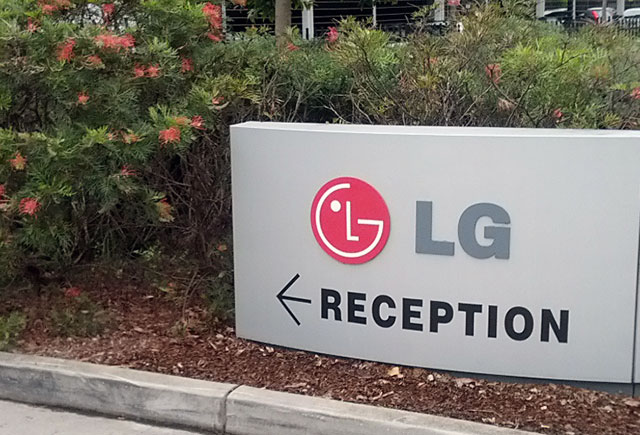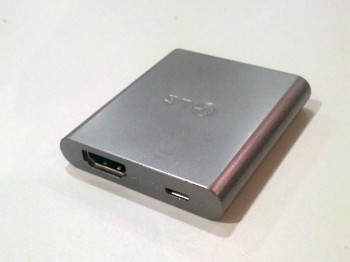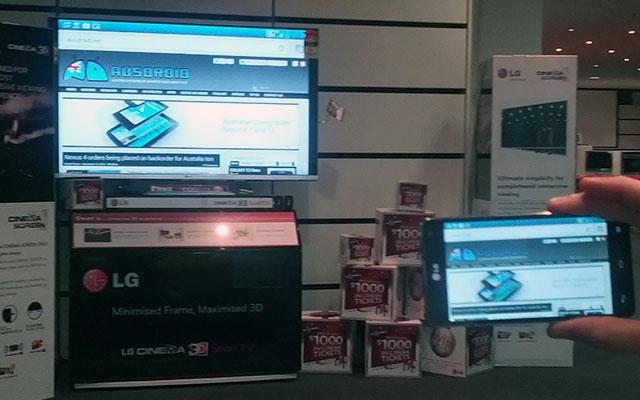
Last week, Dan was invited to a meet-and-greet with LG Australia in Sydney, where he was able to spend some hands-on time with the Nexus 4 and Optimus G. During that meeting we enquired about a more in-depth look at Miracast and LG kindly invited us out to take another look.
This week, LG invited us to its office for the promised hands-on demonstration of Miracast, and a further chance to get familiar with the devices in question.
It’s one thing to meet with company representatives in a press-friendly, neutral location. It’s another thing entirely to visit them at their premises. There’s a home ground advantage implicit in a company’s own building, in their own office, on their own land. LG’s building in Eastern Creek can be seen easily from a distance. It’s large and imposing, though the staff within are anything but.
Like Dan, I met with Brad Reed and Josh Corin – respectively, LG’s Senior Marketing Manager and Local Product Manager for Mobile Communications. They showed me into a demo area, kitted out with a comfortable couch and a large 3D TV. On the opposite wall there was a kitchen, but I wasn’t sure if it was just for show – testing appliances, etc. From my vantage point on the couch, I saw a wall of refrigerators and a line of vacuum cleaners in the adjacent room – a reminder that LG is a large company with a number of disparate product lines.
LG is company poised for great things in the mobile market, and they know it. Having spent a time going after volume in Australia’s prepaid phone market, they’re shifting their focus to the high-end, high-spec, and – let’s face it – high margin end of the market. It’s a space dominated by Samsung, HTC and – more recently – Motorola.
They’re conscious of the fact that to make their mark in this space they need to surpass their competitors’ offerings. In order to do this, they’re using their best technology in their own products rather than selling components as an OEM. LG has spent over $500m to get to where they are today.
As Josh and Brad speak, their pride in LG’s upcoming products is obvious. They have good reason to be proud – as 2012 comes to a close, LG is responsible for not one, but two of the best-regarded products in the Android space – Google’s own Nexus 4 and its close cousin, the Optimus G.

Nexus 4
With the history lesson out of the way, Josh hands me a Nexus 4 – his personal phone. Under any other circumstances, I’d have fainted with excitement, but after this week’s events I’m feeling a little Nexus’d out. While it’s a great device, it no longer has anything to hide.
As Dan noted in his hands-on, the Nexus 4 is far more impressive in the hand than you’d think, even when coming from a Galaxy Nexus. It’s well-built, and has a pleasant feel in the hand, although the glass back does tend to make it a little more slippery to hold than I’d like. The tapered glass edges on the front and soft-touch rubber on the sides give the phone an impressive presence. The overall feel is a solid slab of “wow”, in a way the Nexus line hasn’t really seen under Samsung’s stewardship.
Holding the Nexus 4 and my Galaxy Nexus side by side made me wonder how I’ve used PenTile displays this long without losing my mind. Whites are finally white, and there’s no stippling effect around the edges of onscreen text. The Galaxy Nexus really pales in comparison, and looks more and more like yesterday’s flagship.
Offline Sales
After this week’s sell-outs, the most common question we hear is, “When will Google get more stock to sell?” Alas, LG Australia can’t provide an answer – they are after all the Australian arm of the company and aren’t directly involved in the Google-LG relationship – but the popularity of the device has had an effect on their plans for offline sales, which we originally heard would be detailed later this month.
Brad confirmed very specifically that while Google has exclusivity for online sales of the device, LG will sell the Nexus 4 at retail in Australia starting in around 6 weeks. They have partners lined up ready to sell the device, and are confident you will be able to get one on-contract. While this puts them into 2013, it’s hard to look at these circumstances as a negative – it’s a position Apple and Nintendo have both enjoyed in recent years. They couldn’t be drawn on specific retailers, but will make an announcement when they’re ready.
Accessories
As Dan found, starting a discussion about accessories gets mixed results. LG knows its place in the Nexus program, and properly plays the role of the OEM – they manufacture accessories to order from Google, but are unwilling to say much about them.
Here’s what we know:
- The bumpers we briefly saw for sale on the Play store on Tuesday are produced by LG.
- The Qi wireless charger “orb” is also produced by LG – but Google’s gone quiet on the details.
- It’s possible there’ll be a Nexus-branded Miracast adapter.
On wireless charging, LG sells devices in other territories that conform with the Qi standard, so it’s possible we’ll see some LG-branded Qi chargers in Australia before long.
I brought up the issues encountered by The Verge’s Chris Ziegler using Nokia’s Lumia Qi charging mat with his Nexus 4. Josh pointed out that the induction coils do need to be aligned – you can’t just place the device on a charging mat at any angle – and also mentioned that he has charged his Nexus 4 using a Lumia charger for a few minutes without problems.

Optimus G
Josh also brought the Nexus 4’s sibling, the Optimus G. Since I’ll have my own Nexus 4 on Monday, I was happy to spend a bit more time with the G.
If you’re concerned about the Nexus 4’s 16 GB capacity, you should be aware that LG will be bringing out an Optimus G with 32 GB internal storage.
Physically, the device is the same size as the Nexus 4, but more rectangular. From above, the comparison is obvious with squared-off edges as opposed to the Nexus 4’s top and bottom curves. The tapered edges on the back make it feel more comfortable in the hand than you would think, given the size and shape. Ports, buttons and the camera are in the same location as the Nexus 4.
The Optimus G shares the same internals as the Nexus 4 – although it’s really vice-versa, as it predates the Nexus – but has more storage, a Micro SD slot, 4G LTE connectivity, and a higher megapixel count on its camera. There’s no mistaking the plus points in the inevitable comparison table.
On the software side, it will launch with Android 4.1. The device is already going through regulatory and carrier approval, and the process would be set back several months if the software were to be changed. LG’s software would hide most of the visual changes in Android 4.2, anyway.
The Optimus G has a range of useful functions and neat tricks up its sleeve. You can overlay high-definition video playback on the operating system, and use it as usual without a hint of lag. The QuickMemo function lets you write – literally – on the screen and leave it on-screen, or save it as a note or screenshot. You could literally write on a map or circle an important location and send someone a screengrab, or you can write someone’s phone number down and leave it on-screen while you go to the phone book and create an entry for them later. QuickMemo is important to LG – they’ve assigned it a physical button on the device, a long press on the middle of the volume rocker will activate it.
The Optimus G will see a local release in 2013. LG is finalising the details and isn’t yet ready to announce specifics. While it was fun to play with, we’ll have more detailed coverage of the device closer to its release date.

Miracast
Miracast is a new wireless display technology built on Wifi Direct that has attracted a lot of attention recently as a tentpole feature of Google’s new Nexus 4. Miracast uses Wifi Direct to establish an ad-hoc wifi connection between devices over which it streams video and audio data. It’s similar to Apple’s AirPlay protocol, but with support from major players in the electronics industry like Samsung, Intel, Qualcomm, nVidia and Texas Instruments it will work across a variety of devices from different manufacturers. Gizmodo has a good overview of the technology.
Both the Nexus 4 and Optimus G feature Miracast. On the Nexus 4, it’s supported through Android 4.2’s Secondary Displays, as mentioned in our guide to the Android 4.2 Developers API. On the Optimus G, it’s part of the standard OS and can be enabled with a tap on a dedicated toggle in the notification shade’s Quick Settings area.
Miracast isn’t particularly useful without anything to transmit to, and herein lies its achilles heel – for now. The technology will eventually be incorporated into TVs from LG (and other manufacturers), starting with their 2013 models, but the vast majority of people will use an adapter dongle on one of their TV’s input ports. LG’s Miracast dongle is a small device about the size of a phone battery. It’s powered by a micro USB port. There are no buttons, just HDMI & micro USB ports and a power light.

Once activated, the phone will spend a few seconds searching for suitable devices. LG’s adapter was detected quickly.
Seeing the phone’s complete UI presented “live” on a TV screen, responding to input and device rotation is a bit of an “ah-ha” moment. Suddenly, opportunities present themselves – situations where I could use Miracast instead of plugging in my laptop or transferring files to a USB disk.
There’s a slight dip in the framerate when using Miracast, but it doesn’t detract from the experience. The device prioritises output to the wireless display over its own screen – for example, rotation occurs on the TV display before it occurs on the phone.
Josh’s demonstration included browsing a photo gallery in full-screen mode on the TV, playback of HD video (an MKV file, no less), web browsing, and a game of Angry Birds. The phone can send output to the Miracast display from an application – for example, a video – and continue to use the phone normally. Josh demoed this by playing a video on the TV while playing Angry Birds on the phone.
Occasionally when there was a lot of movement on screen a visual artifact or two appeared, but only briefly – the display recovered quickly each time, in under a second. Bearing in mind that we’re streaming a high definition signal from the phone to the TV over a wireless connection, this is forgivable. This should be reduced in a home environment where there are less wireless devices around to cause potential interference.
I found browsing the web with Miracast a bit lacking. While you can display the browser on the TV, theres no pointer or cursor you can move around – you still need to look at the phone’s screen to know what you’re clicking on, and you won’t see any MORE information on the TV since it’s mirroring the phone’s screen. In most cases (media playback, photos, etc) this wouldn’t be a problem.
Another quirk is that Miracast uses your Wifi antenna, so you can’t maintain a connection to your home network while transmitting and will instead be relying on mobile data. This is a definite drawback compared to competing systems like AirPlay, but it’s something that could be added or changed as Miracast evolves.
Notably, the demo was performed on the Optimus G. There seem to be issues with the implementation on the Nexus 4 which should be sorted out with a software update. This seems OK, as no-one has Miracast-capable hardware at the moment.

There’s no doubt that LG is entering a crowded space at the high end of the Android device market, rubbing shoulders with Samsung’s Galaxy S III, HTC’s One X and Motorola’s RAZR HD. They have two strong and exciting contenders on their hands, and we’ll be watching them closely over the next few months.




Please correct your article. Miracast CAN be used in concert with a Wi-Fi connection. In order to become Miracast certified a device must have a dual band Wi-Fi antenna. It uses the 5GHz band for Miracast. All this means is that your Wi-Fi connection will be kicked down to the 2.4 GHz band if your network even had 5GHz to begin with.
The information supplied in the post in regards to Miracast not working in concert with Wi-Fi whilst in use was given by LG to me during my meeting and to Jason during this meeting.
I am more than willing to update the post if you can supply a specific example of this working but at the time we were shown this was not the case.
Has there been any confirmation of which carriers will sell the Optimus G on contract?
No information as yet, that’ll come out as LG gets closer to launch as per usual.
How about an update for the Optimus Black
LG are pretty cagey about any of the updates for their phones
I know it adds complexity but I wish that Miracast would work over WifiDirect OR Wifi. I did read somewhere that the next version of AirPlay would possibly support WifiDirect.
Agreed, I think it’s a fairly big shortfall in the current implementation.
Optimus G doesn’t have a microsd slot/support!
The Optimus G does have a Micro SD slot. I think it might vary by territory.
good to know. Pity that it won’t be in retail before xmas.
btw two things
there shifting their focus
On the Nexus 4, you it’s supported through Android 4.2’s Secondary Displays
😉
“LG will sell the Nexus 4 at retail in Australia” – methinks this deserves to be the headline of a dedicated post.
I am happy to read this. As one of the many who missed out, I was waiting for the next batch. It’s nice to have another option should I miss out on that too…
We did a similar post already. When LG’s ready to make a proper announcement, we’ll definitely cover it.
Interesting read. I wonder how they’re going to offer it on contact since all the carriers have said they won’t be carrying it. I would love this phone on a Telstra contact…
Optus hasn’t made a statement either way. only virgin, Vodafone and Telstra have said no. then there’s also other resellers with contacts, like crazy John’s, who could be offering it.
But the resellers are all directly connected with one of the carriers, aren’t they? For example, I could never see jb HiFi selling a phone on a Telstra contact that Telstra hadn’t tested and approved. I would imagine the other resellers would be in the same boat…
I’m not sure how tightly coupled they are. A friend got a huawei from crazy john on contract, a phone that vodafone itself didn’t offer, so I imagine there’s some freedom there. (Crazy john uses the vodafone network)